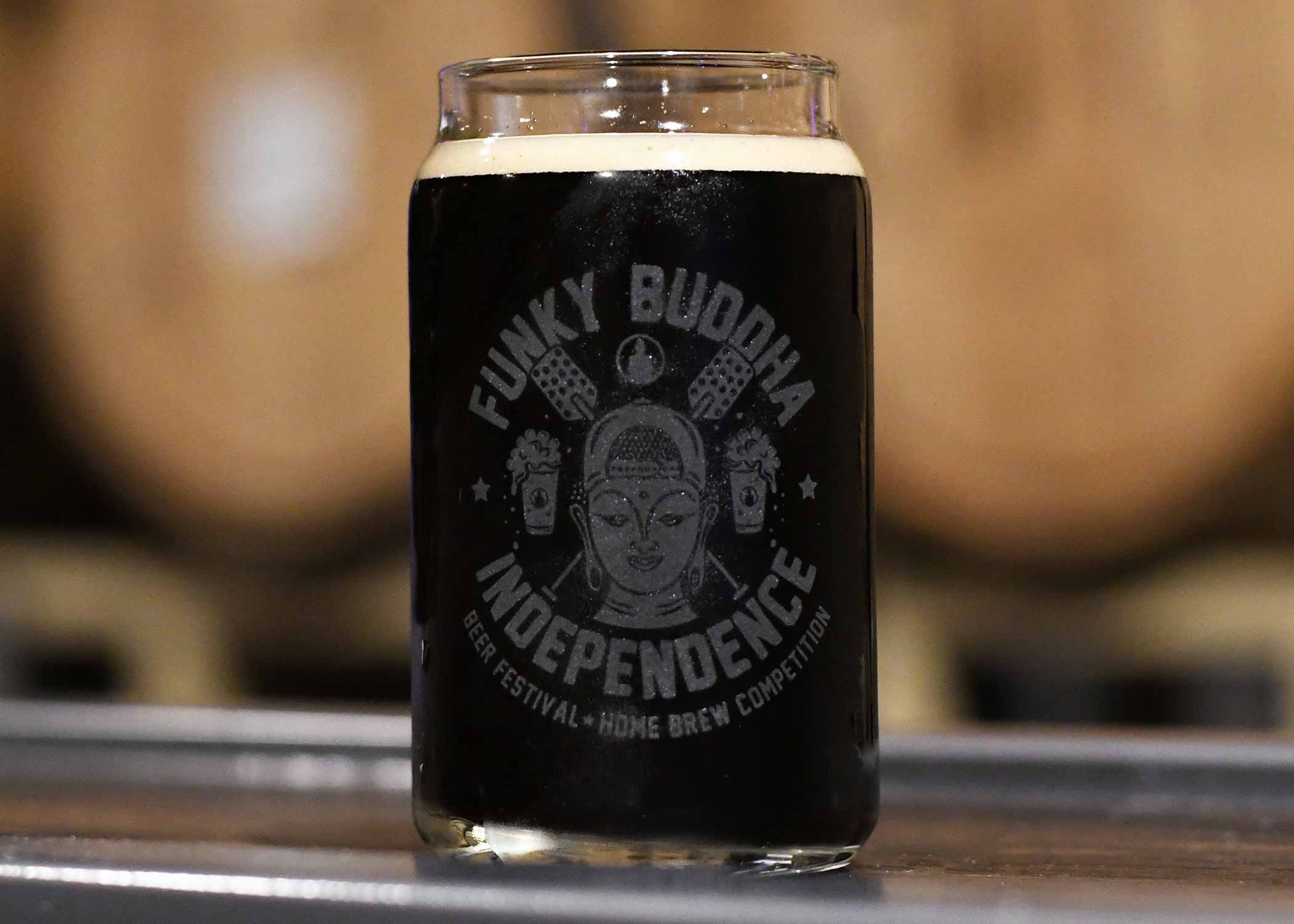Shop
A Day in the Mind of a Homebrew Competition Judge
Professional beer taster.
Hop Culture's Hottest Stories:
I walked down a hallway between the tap room and the barrel room of Funky Buddha Brewery. In the corner I saw a couple of pinball machines, and along the perimeter I gazed on tables adorned with black tablecloths and everything from jockey boxes to unlabeled beer bottles in ice chests. Each table was decorated with banners and totems with the people behind them laughing, smiling, and enjoying different beers. For all intents and purposes, this looked like a beer festival. But I wasn’t here for a beer festival; I was here to score beers from the first-ever Funky Buddha Independence Festival homebrew competition.
Homebrewing laid down my roots in this industry. Many years ago, I joined the Hogtown Brewers Homebrew Club in Gainesville, FL. I participated in about a half-dozen homebrew competitions before officially becoming a Beer Judge Certification Program (BJCP) judge. Over the years, I judged and facilitated over a dozen competitions, mostly while brewing professionally.
Homebrewing is core to many of the breweries that evolved from the craft beer boom in the last twenty-plus years. There is a whimsical sort of romance that goes into brewing your own beer and especially drinking it. For many craft breweries, their businesses began as a dream, an aspiration to serve an artisan, hand-crafted adult beverage made with the same attention to detail you would find in a fine-dining restaurant.
Those like Funky Buddha Brewery.
In 2010, Funky Buddha began as a nano-brewery, hookah, and homebrew shop in East Boca Raton, serving culinary-inspired beers on a small 1-bbl (31-gallon) brewing system. Before expanding into their current home in Oakland Park, the original Funky Buddha location was a sanctuary for homebrewers to share their creations, pick up homebrewing supplies, and meet other homebrewers to share creations while also enjoying Funky Buddha beers. They would often host homebrewer clubs and even beer competitions.
After selling to Constellation Brands in 2017, the original owners, Ryan and KC Sentz, bought back their brewery last year. To celebrate its reacquired autonomy, Funky Buddha hosted its first-ever Independence Festival last June.
A key component of the festival? A nod to the brewery’s original roots: a homebrew competition.
When Funky Buddha’s marketing manager, Kristen Lorow, texted me a month ago about judging the event, I felt a sense of excitement I hadn’t had in years.
I immediately texted back: “I need to check with my wife, but yes!”
What Is a Homebrew Competition All About?
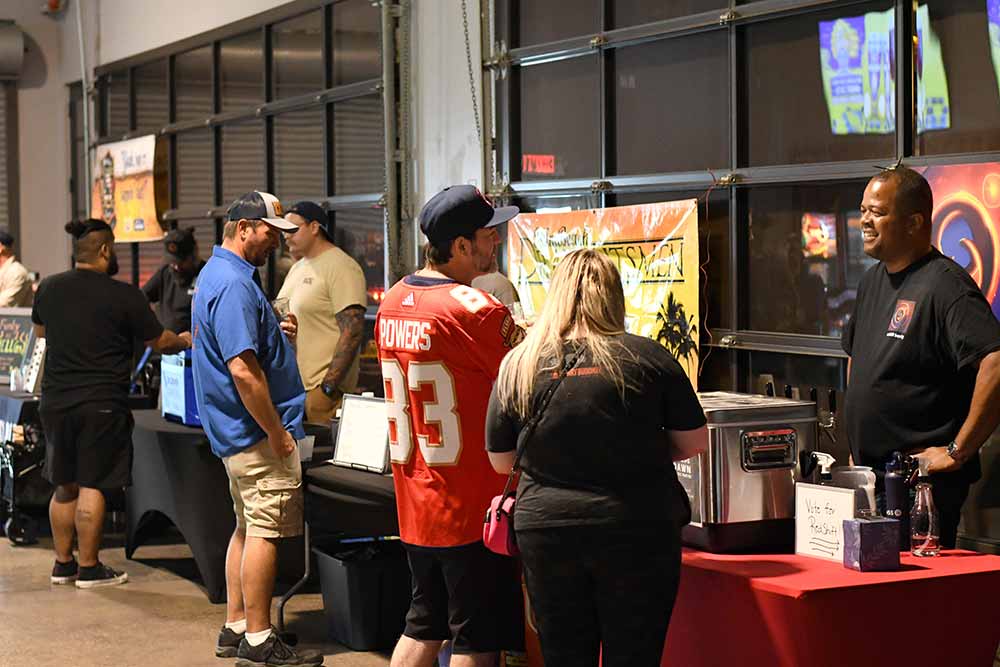
Photography courtesy of Funky Buddha
Logistically, the BJCP sanctions all homebrew competitions, develops the score sheets we use, and records the results from the national events. Sanctioned competitions are scheduled well in advance and have an assembly of volunteers.
These volunteers can range from the organizer who facilitates the event to beer judges who can be BJCP certified or industry professionals.
The BJCP itself does not operate these competitions but provides guidelines on how to judge. While competitions themselves can vary based on the environment and spirit of the event, ultimately, the beers judged should follow these guidelines as closely as possible.
To me, a homebrew competition has a certain level of fondness that I have not observed in any other craft beer event at any level. Probably because participants are so passionate about showcasing what they’ve produced at home.
Funky Buddha’s homebrew festival was no different.
As I walked the competition floor, I could tell from the effort that went into homebrewers’ booths that some certainly desired to “go pro.”
Heading towards the lab to start judging, I ducked and dodged samples eagerly offered, knowing I would cross paths with them soon.
I eventually settled into the lab with the other two judges—a professional brewer and a wine industry vet. With my experience in competitions, I stepped in as the unofficial “lead judge.” Since my fellow judges were not BJCP members, I provided guidance on scoring beers and following the BJCP standards.
For Funky Buddha’s homebrew competition, we scored beers in the “Best In Show” style without restrictions or guidelines and tasted them from lightest to darkest.
With fourteen entries to try, I started preparing my score sheets and chewing on oyster crackers to clear my pallet. More importantly, I mentally prepared myself. Since the submitted entries could range from a homebrewer’s first attempt to an outstanding example of a style, I needed to judge every beer fairly and consistently.
All I needed in front of me now? My first beer.
Writing About Beer: It’s Easier To Score It
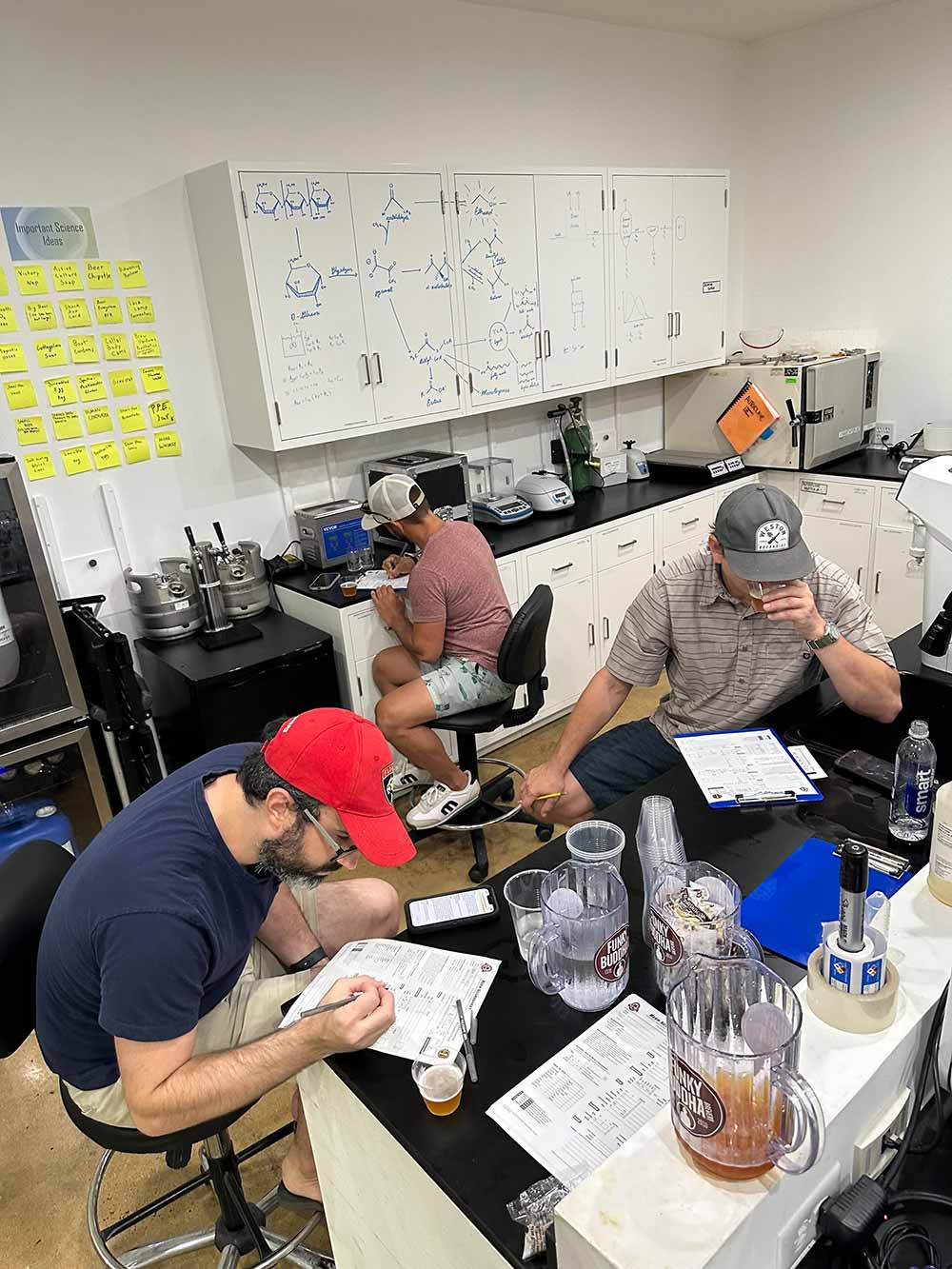
Photography courtesy of Kristen Lorow | Funky Buddha
Much like brewing, judging beer is part art and part science.
The first beer was brought to us and divided into three small plastic cups, one for each judge. I immediately took a swirl of the first cup and covered it with the top of my hand. I wanted to trap the aroma to see what I could detect—the good, the bad, and the ugly.
Lifting my palm gently, I brought the cup to my face and tried to gather what odors I could decipher and put into words.
Classified as an International Pale Lager, the first beer certainly had a “light graininess.” But did I detect a hint of diacetyl? Maybe even a bit of unintended phenols? A clean fermentation is preferable, but a light amount of phenols would not be considered a fault for the style. These are the questions and thoughts that swirled in my brain as I inhaled.
When I took a small sip of the beer and swished it around in my mouth, I grabbed my phone from the table and began reviewing the BJCP Style Guidelines for 2A. International Pale Lager; the description reminded me of what I should ultimately seek in the beer for proper judging.
“A highly-attenuated pale lager without strong flavors, typically well-balanced and highly carbonated,” reads the style guideline. “Served cold, it is refreshing and thirst-quenching.”
Detecting and translating the flavors and aromas I pick up is the easy part. But the most critical question to always answer: How does the beer I’m judging pair up against a classic example of the style? Which in this case, peering at the BJCP guidelines for this style, a Heineken or a Corona Extra.
In my notes for this first beer, I scribbled “low medium malt aroma” and described the texture of the head retention as “creamy.”
When it comes to actually scoring what we tasted, I noted ”a little corn.” I also mentioned that it had DMS and a lingering bitterness.
In a section on overall impression, we judged the beer based on face value, not stylistic accuracy, and give suggestions for improvement (which is encourage by the BJCP). For this beer, I said it was a pleasant, easy-drinking lager, but the lingering bitterness was a little too much for the style, mentioning they can reduce the amount of hops in the boil to smooth it out and decrease the bitterness.
When we completed writing independently, the three of us rolled our chairs to face each other, discussing our scores. Overall, we gave the first beer a score of thirty-three out of fifty, a Very Good rating, which according to the BJCP means beers have a minor technical or stylistic flavor but overall has no major flaws and fits the style well.
The Good, The Excellent, and The Surprising
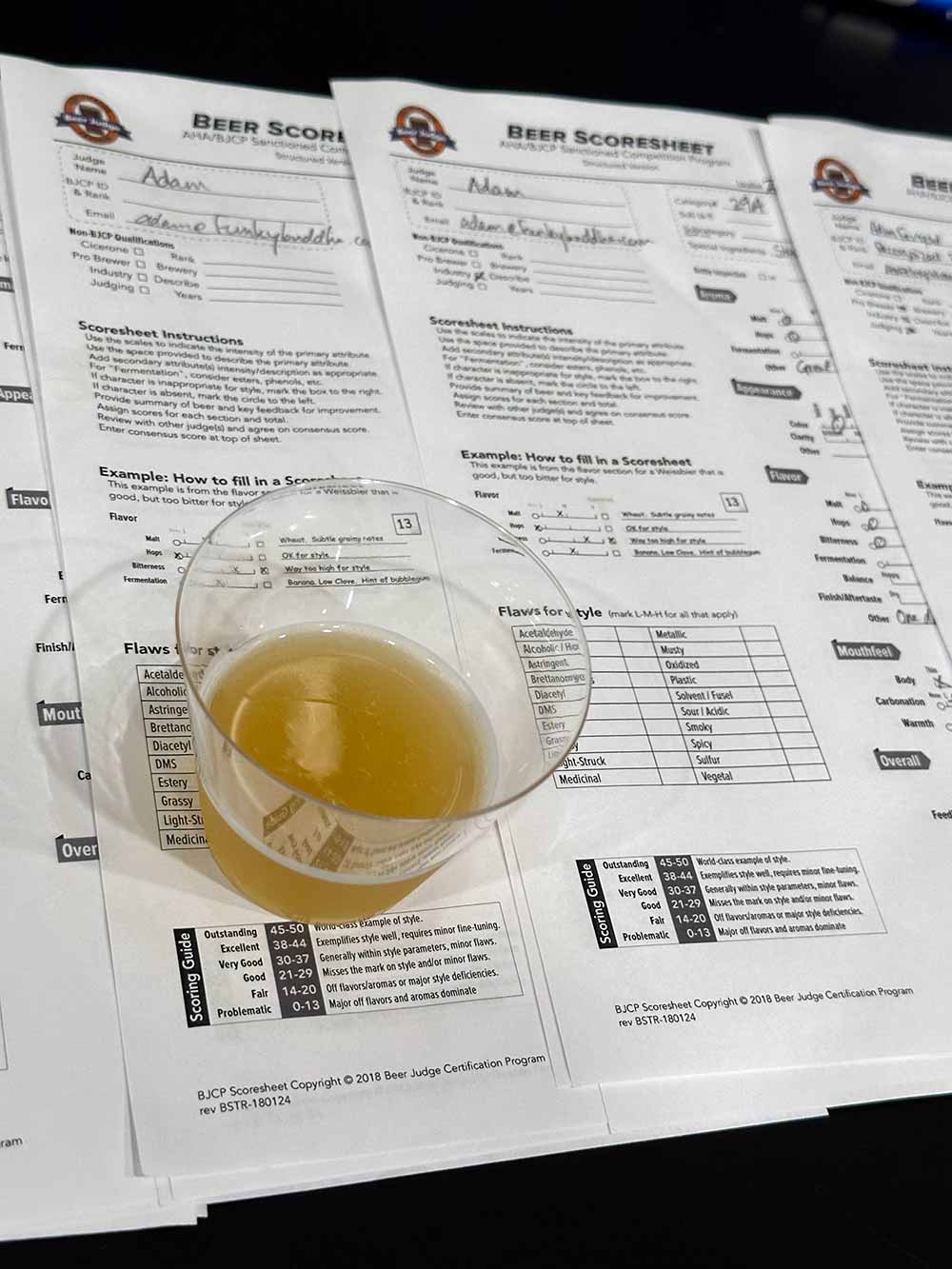
Photography courtesy of Kristen Lorow | Funky Buddha
Homebrewing competitions can often be up and down. You’ll find good beers, some that need work, and others that genuinely surprise you.
Eventually, between the light beer categories and a medicinal-tasting cherry seltzer, we tried a few IPAs. As a homebrewer and former professional brewer, I have rarely found a homebrewed IPA that can stack against a professionally brewed one.
I believe this is because it’s harder for a homebrewer to control the oxygenation of hops, which can affect the aroma or flavor during fermentation or packaging.
Surprisingly, of the three IPAs submitted for judging, the hazy IPA won third place with a score over thirty-nine. The beer impressed me with a fantastic aroma and excellent mouthfeel to match; the flavor was smooth but had too much bitterness.
I rarely finish my samples when judging beer, let alone go back for a second one. But a few beers in, we were suddenly graced with a saison that was so delightful I couldn’t help myself. I wrote down words like “harmony,” “elegance,” and “complexity.”
In my opinion, someone could have professionally brewed this beer; it certainly fooled me. We scored this beer over forty-two, classifying it as Excellent and winner of the entire competition.
We finished the judging with the darker beers, and a Czech dark lager (a personal favorite style of mine) really impressed me.
When I drink a dark lager brewed well, I feel like I have just received a love letter to beer. This excellent example had a fantastic balance of rich, dark, and medium-light roast notes. We scored the beer over forty—high enough to nab second place.
On the other hand, a Baltic porter ended up surprising all of us. Although the lager had nice notes of dark caramel and robust chocolatey flavor, we found a few flaws, including being under-carbonated, which may have affected every other aspect of the beer.
We felt this submission could have been more inspired. I scored this beer under thirty, qualifying it as Good, described by the BJCP as “Missing the mark on style and/or moderate flaws.”
But surprisingly, this Baltic porter won the People’s Choice Award, granted to the beer that collects the most tickets or tokens from attendees.
Why Homebrewing Competitions Are Timeless
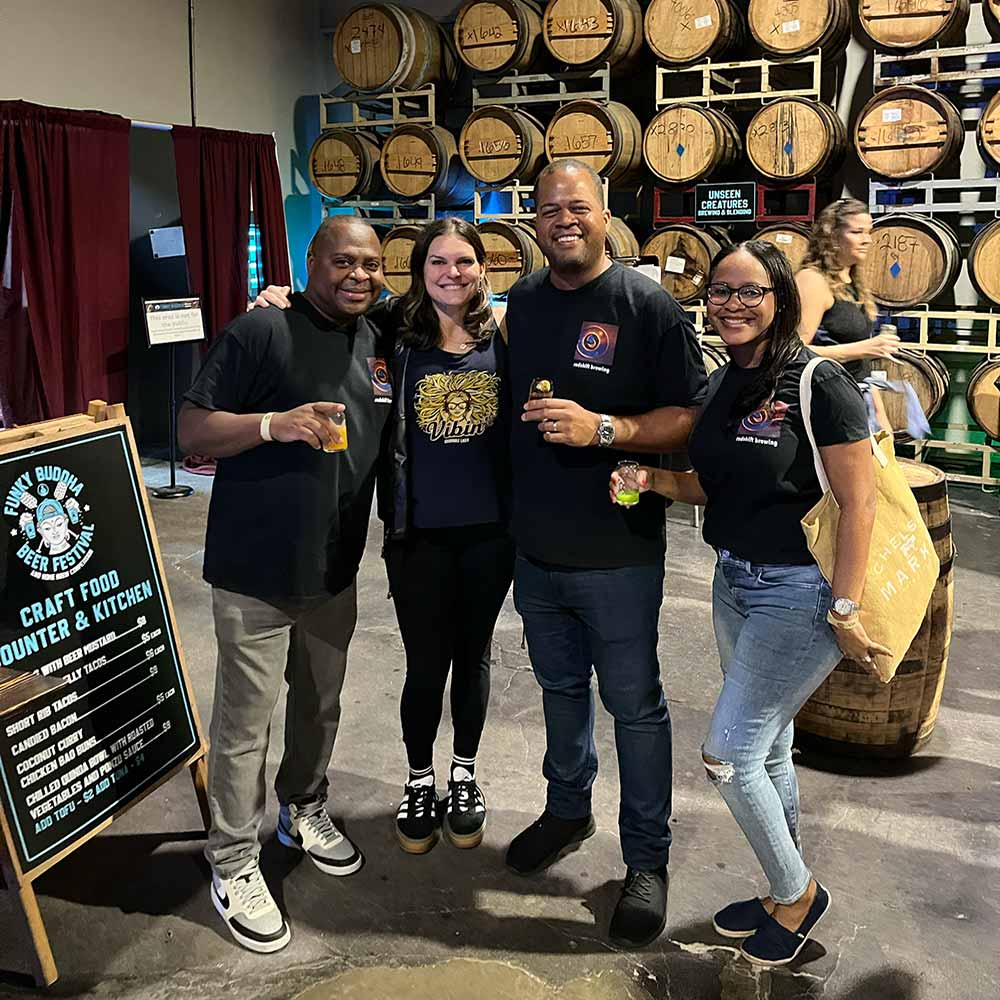
Photography courtesy of Kristen Lorow | Funky Buddha
Once we were done judging, we made our way into the Funky Buddha Barrel Room, where the Independence Festival was being hosted. Homebrewers shuffled into the room to listen to the results. As the third, second, and first place and People’s Choice Awards were announced, people shouted and cheered.
I have dedicated over a decade of my life to craft beer both as a hobbyist and professional, and homebrew competitions are a humble reminder that style is not everything and that tastes are subjective. That is the beauty of craft beer; with enough practice, anyone can brew it at an elevated level.
I am glad Funky Buddha included a homebrew competition in their Independence Festival because I believe that where the craft beer movement started and what will continue to drive its future.
Who knows, maybe one of these homebrewers will even open a brewery someday.

